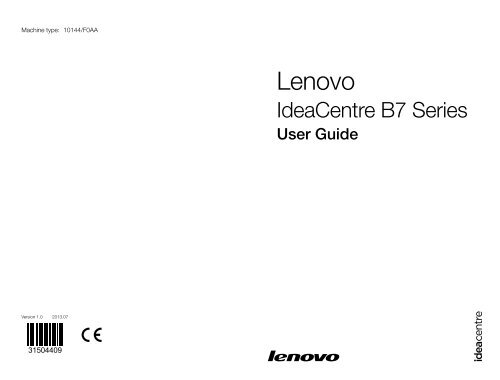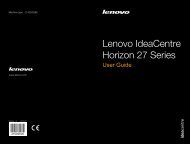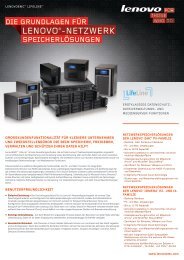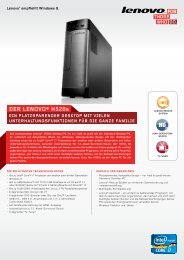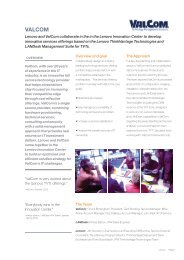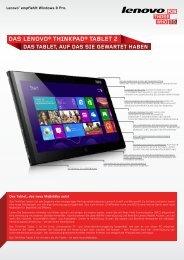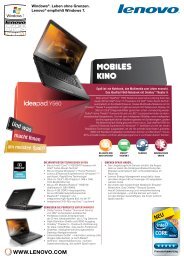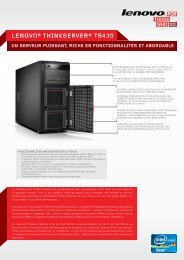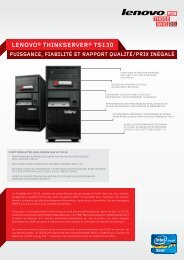User Guide - Lenovo
User Guide - Lenovo
User Guide - Lenovo
You also want an ePaper? Increase the reach of your titles
YUMPU automatically turns print PDFs into web optimized ePapers that Google loves.
Machine type: 10144/F0AA<br />
<strong>Lenovo</strong><br />
IdeaCentre B7 Series<br />
<strong>User</strong> <strong>Guide</strong><br />
Version 1.0<br />
2013.07<br />
31504409
Important Safety Information<br />
Before using this manual, it is important that you read and understand all of the<br />
related safety information for this product. Refer to the Safety and Warranty <strong>Guide</strong><br />
that you received with this product for the latest safety information. Reading and<br />
understanding this safety information reduces the risk of personal injury or product<br />
damage.<br />
The interface and functions shown in this <strong>User</strong> <strong>Guide</strong> are provided for reference<br />
only and may differ from actual product appearance. Product design and<br />
specifications may be changed without notice.<br />
Danger: Be aware of extremely hazardous or potentially lethal situations.<br />
Attention: Be aware of possible damage to programs, devices, or data.<br />
Note: Pay attention to this important information.<br />
© Copyright <strong>Lenovo</strong> 2013. All rights reserved.<br />
LIMITED AND RESTRICTED RIGHTS NOTICE: If data or software is delivered<br />
pursuant a General Services Administration “GSA” contract, use, reproduction, or<br />
disclosure is subject to restrictions set forth in Contract No. GS-35F-05925.
Contents<br />
Important Safety Information<br />
Using the Computer Hardware.................................................. 1<br />
Front view of the computer.........................................................................2<br />
Left and right views of the computer...........................................................3<br />
Rear view of the computer..........................................................................4<br />
Installing the computer stand......................................................................5<br />
Computer stand..........................................................................................6<br />
Basic connector instructions.......................................................................6<br />
Connecting your computer.........................................................................7<br />
Important information about using the computer.........................................8<br />
Connecting to the Internet..........................................................................9<br />
Wired keyboard (selected models only).....................................................10<br />
Using Windows 8....................................................................... 11<br />
Switching between the main Windows 8 interfaces...................................12<br />
The Charms Bar.......................................................................................12<br />
Shutting down the computer....................................................................12<br />
Switching between apps...........................................................................13<br />
Closing an app.........................................................................................13<br />
Opening other system programs...............................................................13<br />
Windows Help and Support......................................................................13<br />
Using the Rescue System........................................................ 15<br />
OneKey Recovery.....................................................................................16<br />
Driver and Application Installation..............................................................17<br />
Using the Software................................................................... 19<br />
<strong>Lenovo</strong> Support........................................................................................20<br />
Contents<br />
i
Troubleshooting and Confirming Setup.................................. 21<br />
Troubleshooting Display Problems............................................................22<br />
Troubleshooting Audio Problems...............................................................23<br />
Troubleshooting Software Problems..........................................................24<br />
Troubleshooting Problems with Optical Drives and Hard Disks..................24<br />
Special considerations for troubleshooting Windows.................................25<br />
Windows Help and Support......................................................................26<br />
BIOS setup utility......................................................................................26<br />
Performing Daily Maintenance Tasks.........................................................27<br />
Hardware Replacement <strong>Guide</strong>................................................. 29<br />
Overview...................................................................................................30<br />
Replacing hardware..................................................................................33<br />
Appendix.................................................................................... 45<br />
Declaration...............................................................................................45<br />
Trademarks...............................................................................................46<br />
Energy Star Statement..............................................................................47<br />
Enabling ErP compliance mode................................................................48<br />
ii<br />
Contents
Using the Computer Hardware<br />
This chapter contains the following<br />
topics:<br />
‣ Introduction to the computer hardware<br />
‣ Information on computer connections<br />
Note: The descriptions in this chapter<br />
might be different from what you see on<br />
your computer, depending on the computer<br />
model and configuration.<br />
<strong>User</strong> <strong>Guide</strong> 1
Front view of the computer<br />
Attention: Be careful not to block any air vents on the computer. Blocked<br />
air vents can cause overheating.<br />
1 2 3 1<br />
4<br />
5<br />
6<br />
7<br />
8 9 10 11 12 13 14<br />
Built-in microphones (2)<br />
Camera LED indicator<br />
Built-in camera Built-in IR receiver 1<br />
Hard disk drive indicator<br />
Bluetooth status indicator<br />
Wi-Fi status indicator<br />
Volume down<br />
Volume up<br />
Brightness down<br />
Brightness up<br />
Novo Vision switch<br />
PC mode/HDMI-in switch<br />
Monitor ON/OFF<br />
1<br />
Only functional on models equipped with a IR receiver module.<br />
Attention: The effective range of the Built-in IR Emitter is 10 feet.<br />
2 <strong>User</strong> <strong>Guide</strong>
Left and right views of the computer<br />
1<br />
2<br />
3<br />
4<br />
5<br />
6<br />
7<br />
USB 3.0 connector<br />
Microphone connector<br />
Memory card reader<br />
Power button<br />
Headphone connector<br />
USB 3.0 connector<br />
Optical drive eject button<br />
<strong>User</strong> <strong>Guide</strong><br />
3
Rear view of the computer<br />
Attention: Be sure not to block any air vents on the computer. Blocked<br />
air vents may cause thermal problems.<br />
8<br />
3<br />
7<br />
1<br />
2 4 5 6<br />
TV tuner connector<br />
(selected models only)<br />
HDMI-in connector<br />
Ethernet connector<br />
HDMI-out connector<br />
USB 3.0 connectors (2) USB 2.0 connectors (2)<br />
Power connector<br />
Air vents<br />
4 <strong>User</strong> <strong>Guide</strong>
Installing the computer stand<br />
Note: It may be helpful to place the computer face-down on a soft flat<br />
surface for this procedure. <strong>Lenovo</strong> recommends that you use a blanket,<br />
towel, or other soft cloth to protect the screen from scratches or other<br />
damage.<br />
1. Raise the stand holder.<br />
1<br />
2. Line up the stand base with the mounting holes in the stand holder, then push<br />
the stand base into position.<br />
3. Pull the hand screw ring up, then secure the stand base to the stand holder<br />
with the hand screw.<br />
3<br />
2<br />
4. Press down the hand screw ring.<br />
<strong>User</strong> <strong>Guide</strong><br />
5
Computer stand<br />
Use the stand to position the display to your preference. It can be rotated 5º<br />
forward and 25º backward.<br />
Basic connector instructions<br />
Note: Your computer may not have all of the connectors described in this<br />
section.<br />
Connector<br />
Microphone<br />
Headphone<br />
USB connector<br />
Ethernet connector<br />
HDMI connector<br />
Description<br />
Use this connector to attach a microphone to your<br />
computer when you want to record sound or if you use<br />
speech-recognition software.<br />
Use this connector to attach headphones to your<br />
computer when you want to listen to music or other<br />
sounds without disturbing anyone.<br />
Use this connector to attach a device that requires a USB<br />
connection.<br />
Use this connector to attach the computer to an Ethernettype<br />
local area network.<br />
Connects to the HDMI connector on your display or TV.<br />
6 <strong>User</strong> <strong>Guide</strong>
TV-Tuner connector<br />
(optional)<br />
Connects to an external antenna to view programs using<br />
the optional TV tuner card.<br />
Note: If your computer is equipped with a wireless keyboard or mouse,<br />
follow the installation instructions for those devices.<br />
Connecting your computer<br />
Connecting the power cord<br />
Connect the power cord to an electrical outlet. We recommend using a grounded<br />
connection or a surge protector.<br />
<strong>User</strong> <strong>Guide</strong><br />
7
Important information about using the<br />
computer<br />
Press the power button on the side of the computer to turn on the computer.<br />
Hold the computer tightly when you carry it.<br />
8 <strong>User</strong> <strong>Guide</strong>
Connecting to the Internet<br />
To connect to the Internet, you’ll need a contract with an Internet Service Provider<br />
(ISP) and some hardware.<br />
IPSs and ISP offerings vary by country. Contact your ISP for offerings available in<br />
your country.<br />
Your computer is designed to support a wireless (selected models only) or wired<br />
network that connects your computer to other devices.<br />
Wired network connection<br />
For wired networks, connect one end of an Ethernet cable (purchased separately)<br />
to the Ethernet connector on your computer, and then connect the other end to<br />
the network router or broadband modem. Consult your ISP for detailed setup<br />
instructions.<br />
Note: Broadband modem and router installation procedures vary<br />
depending on the manufacturer. Follow the manufacturer’s instructions.<br />
Wireless network connection<br />
For wireless networks, you can use the built-in wireless LAN antenna to access<br />
your wireless home network.<br />
To connect your computer to the wireless network:<br />
1. Move the cursor to the top right or bottom right corner of the screen, then click<br />
Settings. (If your computer is equipped with touch screen, swipe in from the<br />
right edge of the screen, then tap Settings.)<br />
2. Click or tap the network icon , then select the name of your router. Click or<br />
tap Connect, then follow the steps on the screen.<br />
Test the wireless network by opening your Web browser and accessing any Web<br />
site.<br />
<strong>User</strong> <strong>Guide</strong><br />
9
Wired keyboard (selected models only)<br />
LVT —— After entering Windows, press this key to launch the LVT (<strong>Lenovo</strong><br />
Vantage Technology) program, <strong>Lenovo</strong>’s pre-loaded Home PC software.<br />
In addition to its own functions, the LVT program will allow you to start<br />
other Windows compatible software specially configured to run on this<br />
model of computer.<br />
Notes:<br />
• Some models are not equipped with the LVT program.<br />
• The LVT key on the keyboard is disabled in the models<br />
without the LVT program.<br />
F2 —— Your computer has the <strong>Lenovo</strong> Rescue System installed. To learn more<br />
about this program, repeatedly press and release the F2 key once<br />
turning on the computer until the <strong>Lenovo</strong> Rescue System open.<br />
10 <strong>User</strong> <strong>Guide</strong>
Using Windows 8<br />
This chapter contains the following<br />
topics:<br />
‣ Switching between the main Windows 8 interfaces<br />
‣ The Charms Bar<br />
‣ Shutting down the computer<br />
‣ Switching between apps<br />
‣ Closing an app<br />
‣ Opening other system programs<br />
‣ Windows Help and Support<br />
Attention: The Windows 8 operating system<br />
is provided by Microsoft Corporation. Please<br />
use it in accordance with the END USER<br />
LICENSE AGREEMENT (EULA) between you<br />
and Microsoft. For any question related to the<br />
operating system, please contact Microsoft<br />
directly.<br />
<strong>User</strong> <strong>Guide</strong> 11
Switching between the main Windows 8<br />
interfaces<br />
Windows 8 comes with two main user interfaces: the Start Screen and the<br />
Windows desktop.<br />
To switch from the Start Screen to the Windows desktop, do one of the following:<br />
• Select the Windows desktop tile on the Start Screen.<br />
• Press the Windows key + D.<br />
To switch from the desktop to the Start Screen, do one of the following:<br />
• Select Start from the Charms Bar.<br />
• Move the cursor to the bottom left corner, then select the Start Screen<br />
thumbnail when it is displayed.<br />
• Press the Windows key .<br />
The Charms Bar<br />
Charms provide new and faster ways to perform many basic tasks.<br />
To display the charms, do one of the following:<br />
• Move the cursor to the top right or bottom right corner of the screen.<br />
• If your computer is equipped with touch screen, swipe in from the right edge of<br />
the screen.<br />
• Press the Windows key + C.<br />
Shutting down the computer<br />
To shut down the computer:<br />
1. Move the cursor to the top right or bottom right corner of the screen, then click<br />
Settings. (If your computer is equipped with touch screen, swipe in from the<br />
right edge of the screen, then tap Settings.)<br />
2. Select Power → Shutdown.<br />
12 <strong>User</strong> <strong>Guide</strong>
Switching between apps<br />
Sometimes you want to get back to an app you were just using, or quickly switch<br />
through your recent apps.<br />
To switch between apps:<br />
Move the cursor to the top left corner, then click to bring in the next app. (If your<br />
computer is equipped with touch screen, swipe in from the left edge of the screen<br />
to bring in the next app.)<br />
Closing an app<br />
To close an app, do one of the following:<br />
• Move the cursor to the top left corner of the screen. When the thumbnail<br />
appears, drag it to the bottom of the screen.<br />
• Move the cursor to the top edge of the screen. When the cursor becomes a<br />
hand, drag the app page to the bottom of the screen.<br />
• If your computer is equipped with touch screen, swipe in from the top edge of<br />
the screen. When the app page becomes smaller, drag it to the bottom of the<br />
screen.<br />
Opening other system programs<br />
There is a fast way to open other system programs.<br />
To open the menu, do one of the following:<br />
• Move the cursor to the bottom left corner of the screen. When the thumbnail<br />
appears, right-click with the mouse to open the menu.<br />
• Press the Windows key + X.<br />
Windows Help and Support<br />
If you have a problem with the operating system, see the Windows Help and<br />
Support file. To open the Windows Help and Support file, do one of the following:<br />
• Select the Settings charm, then select Help.<br />
• Press the Windows key + F1.<br />
You can read the Windows Help and Support file on your computer. You can also<br />
get online help and support by clicking on one of the two links listed under More<br />
to explore.<br />
<strong>User</strong> <strong>Guide</strong><br />
13
14 <strong>User</strong> <strong>Guide</strong>
Using the Rescue System<br />
This chapter contains the following<br />
topics:<br />
‣ OneKey Recovery<br />
‣ Driver and Application Installation<br />
Attention: Using OneKey Recovery will result<br />
in loss of data.<br />
• You can restore the C: drive of the computer<br />
to factory default settings or to the last system<br />
backup status using OneKey Recovery. If you<br />
do this, all of the existing data on drive C: will<br />
be lost, but the content and format of the other<br />
partitions of the hard disk drive will remain<br />
unchanged.<br />
• If you want to install an operating system and<br />
back it up with OneKey Recovery, you must<br />
format the C: partition in NTFS format and<br />
install the operating system on the C: partition.<br />
Otherwise, the OneKey Recovery system cannot<br />
run.<br />
<strong>User</strong> <strong>Guide</strong> 15
Note about the service partition:<br />
The files and relevant data used by the rescue system are saved in the service<br />
partition. Deleting this partition will make the rescue system unusable. For more<br />
detailed information, see the following instructions:<br />
From the Search charm, select Apps → Control Panel → Administrative Tools<br />
→ Computer Management → Disk Management, you can see the service<br />
partition, which must not be deleted.<br />
Note: The recovery files and relevant data used by the rescue system are<br />
saved in the service partition. If the service partition is deleted or damaged<br />
by someone other than authorized <strong>Lenovo</strong> service personnel, <strong>Lenovo</strong> will<br />
not be liable for any losses arising therefrom in any way.<br />
OneKey Recovery<br />
OneKey Recovery is an easy-to-use application. You can use it to restore your<br />
computer to the system default or to a previously backed up state.<br />
Detailed Operation Procedure<br />
1. Repeatedly press and release the F2 key once turning on the computer until<br />
the <strong>Lenovo</strong> Rescue System opens, then select OneKey Recovery.<br />
Note: System Recovery will overwrite all of the data on the C: drive. To<br />
prevent loss of data, be sure to back up relevant data before performing<br />
system recovery.<br />
2. Follow the on-screen instructions to select the backup task you want to restore<br />
from and the disk where you want to install the operating system, then press<br />
Next to start the restore.<br />
3. Please wait during the process of system recovery. Do not interrupt the<br />
operation during the recovery process.<br />
4. After the system is recovered successfully, the software will prompt you to<br />
restart the computer. Restart the computer and start the operating system.<br />
16 <strong>User</strong> <strong>Guide</strong>
Driver and Application Installation<br />
The Driver and Application Installation function in the rescue system provides a<br />
way for the user to conveniently reinstall all of the <strong>Lenovo</strong> applications and drivers<br />
that were shipped with your <strong>Lenovo</strong> hardware.<br />
Method 1: Automatic Installation<br />
Repeatedly press and release the F2 key once turning on the computer until the<br />
<strong>Lenovo</strong> Rescue System opens, then select Driver and Application Installation.<br />
Follow the on-screen prompts to install the <strong>Lenovo</strong> drivers and applications. Click<br />
OK to start installing the <strong>Lenovo</strong> Driver and Application Installation software.<br />
The system will restart. After the system has restarted, the drivers and application<br />
installation process will continue until it has completed.<br />
Method 2: Manual Installation<br />
In the Windows system, Select Driver and Application Installation from the<br />
Search charm.<br />
After starting the procedure, install the drivers and software manually by following<br />
the prompts.<br />
Notes:<br />
1. Do not install software which is already installed on the computer.<br />
2. Make sure that the Driver and Application Installation software has been<br />
automatically installed before starting the operating system. The manual<br />
installation function can only be used after the software has been<br />
installed.<br />
<strong>User</strong> <strong>Guide</strong><br />
17
18 <strong>User</strong> <strong>Guide</strong>
Using the Software<br />
This chapter contains the following<br />
topic:<br />
‣ Software instructions<br />
Note: The interface and functionality of these<br />
features will depend on which software<br />
was shipped with the computer model you<br />
purchased.<br />
<strong>User</strong> <strong>Guide</strong> 19
<strong>Lenovo</strong> Support<br />
The <strong>Lenovo</strong> Support program enables you to register your computer with <strong>Lenovo</strong>,<br />
download and view user manuals for your computer, get the warranty information<br />
of your computer, and explore help and support information.<br />
To open this program, do the following:<br />
Click the <strong>Lenovo</strong> Support icon from the Start Screen or Search Screen.<br />
The main functions of this program are listed below. (This program supports<br />
online upgrades. The functions shown below are for reference only, functionality will<br />
depend on the program icons currently displayed.)<br />
Registration<br />
Registration provides you with access to product support, upgrades and alerts on<br />
topics. Take advantage of award-winning <strong>Lenovo</strong> services.<br />
<strong>User</strong> <strong>Guide</strong><br />
The <strong>User</strong> <strong>Guide</strong> provides more information about your computer.<br />
Service and Warranty<br />
You can extend the warranty of your computer through this option. <strong>Lenovo</strong><br />
provides flexible options to meet your personal or business needs.<br />
20 <strong>User</strong> <strong>Guide</strong>
Troubleshooting and<br />
Confirming Setup<br />
This chapter contains the following<br />
topic:<br />
Ø Troubleshooting and Problem Resolution<br />
<strong>User</strong> <strong>Guide</strong> 21
Solving Problems<br />
Follow these tips when troubleshooting your computer:<br />
• If you added or removed a part before the problem started, review the<br />
installation procedures to ensure that the part is correctly installed.<br />
• If a peripheral device does not work, ensure that the device is properly<br />
connected.<br />
• If an error message appears on the screen, write down the exact message.<br />
This message may help support personnel diagnose and fix the problem(s).<br />
• If an error message occurs in a program, see the Help document of this program.<br />
Troubleshooting Display Problems<br />
Problem: Blank screen or no image is displayed on the monitor.<br />
Troubleshooting and problem resolution:<br />
1. Make sure the power cord is plugged into your computer and a functioning<br />
power outlet.<br />
2. Unplug the power cord and plug the power cord back in securely and restart<br />
the computer.<br />
If still cannot solve the problem, contact <strong>Lenovo</strong> Customer Service.<br />
Problem: You need to change the display property settings.<br />
Setting display background and icon properties:<br />
1. Right-click the desktop anywhere except over an icon, then select Personalize<br />
from the pop-up menu.<br />
2. From here, select the appropriate options to:<br />
• Change the desktop background<br />
• Select a screen saver<br />
• Select Windows color options for borders and taskbar<br />
• Select a themes<br />
3. Right-click the desktop anywhere except over an icon, then select Screen<br />
resolution from the pop-up menu to change the appearance.<br />
22 <strong>User</strong> <strong>Guide</strong>
Problem: Ripple on screen.<br />
Troubleshooting and problem resolution:<br />
1. Check to see if any of the following devices are located less than one meter<br />
from the computer: refrigerators, electric fans, electric dryers, UPS systems,<br />
regulators, fluorescent lamps or other computers that may be generating<br />
magnetic interference.<br />
2. Move any interfering devices away from the computer.<br />
3. If the problem persists, contact <strong>Lenovo</strong> Service.<br />
Troubleshooting Audio Problems<br />
Problem: No sound from the integrated speakers.<br />
Troubleshooting and problem resolution:<br />
• Adjust the Windows volume control — select the speaker icon from the<br />
Settings Charm or click the arrow on taskbar to show the hidden icons in<br />
Windows desktop mode, then click the speaker icon. Ensure that the volume<br />
is turned up and the sound is not muted. Adjust the volume, bass, or treble<br />
controls to eliminate distortion.<br />
• Reinstall the audio driver.<br />
• Disconnect any headphones from the headphone connector — sound from<br />
the speakers is automatically disabled when headphones are connected to the<br />
computer’s side-panel headphone connector.<br />
Problem: No sound from headphones.<br />
Troubleshooting and problem resolution:<br />
• Check the headphone cable connection — ensure that the headphone cable is<br />
securely inserted into the headphone connector.<br />
• Adjust the Windows volume control — select the speaker icon from the<br />
Settings Charm or click the arrow on taskbar to show the hidden icons in<br />
Windows desktop mode, then click the speaker icon. Ensure that the volume is<br />
turned up and the sound is not muted.<br />
<strong>User</strong> <strong>Guide</strong><br />
23
Troubleshooting Software Problems<br />
Problem: You are unable to exit a running program normally.<br />
Troubleshooting and problem resolution:<br />
1. Press the Ctrl, Alt and Delete keys at the same time, then select the Task<br />
Manager option from the pop-up dialog box.<br />
2. Select the problem program, then click the End Task button.<br />
Problem: You need to install or uninstall a program.<br />
Problem resolution:<br />
During installation never abort the install process by powering the system off or<br />
through other drastic means. This can cause system program problems or even<br />
failure during system initialization.<br />
During the uninstall process, never directly delete the files or folders. This is<br />
harmful to the operating system, and might cause a system-wide malfunction.<br />
Use the following procedure to properly uninstall programs:<br />
1. Back up all documents and system settings related to the program before<br />
removing it.<br />
2. If the program has its own uninstaller, run it directly to uninstall the program.<br />
3. If the program does not have its own uninstaller, then select Apps → Control<br />
Panel from the Search charm.<br />
4. From the Control Panel, choose Programs → Programs and Features.<br />
5. Find the applicable program from the Programs and Features dialog box and<br />
then select Uninstall/Change.<br />
6. Perform the instructions displayed to uninstall the software.<br />
Troubleshooting Problems with Optical<br />
Drives and Hard Disks<br />
Problem: The Optical drive is unable to read a CD/DVD.<br />
Troubleshooting and problem resolution:<br />
1. Check to determine if there is an optical drive icon in the resource manager<br />
of the operating system. If not, restart your computer. If there is still no icon,<br />
contact <strong>Lenovo</strong> Service. Otherwise, continue with the next step of this<br />
procedure.<br />
24 <strong>User</strong> <strong>Guide</strong>
2. Confirm that the CD/DVD has been properly placed in the drive. If not, reload<br />
the CD or DVD. Otherwise, continue with the next step of this procedure.<br />
3. Check the specifications that came with your computer to confirm that this<br />
optical drive is capable of reading this type of CD or DVD.<br />
4. If the CD/DVD cannot be read, replace it with a known good CD/DVD such as<br />
one that was shipped with the computer.<br />
5. If the known good CD cannot be read, visually check the operating side of the<br />
CD/DVD for defects.<br />
Problem: The capacity of the hard disk, as indicated by the system, is less than<br />
the nominal capacity.<br />
Troubleshooting and problem resolution: For computers equipped with the<br />
OneKey Recovery feature, the system recovery feature needs to occupy some<br />
hard disk space. This may account for the apparent hard disk capacity deficit.<br />
Further Technical Explanation: The nominal capacity of the hard disk is<br />
expressed in the decimal system as 1000 bytes. But the actual hard disk capacity<br />
is expressed in the binary system as 1024 bytes (For example, the nominal<br />
capacity 1G is 1000M, while the actual capacity 1G is 1024M).<br />
The capacity of the hard disk shown in Windows can be calculated according to<br />
the calculations in the following example:<br />
The nominal capacity of the hard disk is 40G, while its actual capacity should<br />
be: 40 x 1000 x 1000 x 1000/(1024 x 1024 x 1024) = 37G.<br />
If the Service partition of 3G - 3 x 1000 x 1000 x 1000/(1024 x 1024 x 1024) =<br />
2.79G is subtracted, the capacity of the hard disk shown in the system can<br />
be obtained.<br />
The capacity of the hard disk as calculated using this method may be slightly<br />
different from the actual capacity due to the rounding of totals.<br />
Special considerations for troubleshooting<br />
Windows<br />
Record the following information as it may be useful later when troubleshooting<br />
system problems:<br />
The drivers for this computer model only support the Windows 8 system.<br />
<strong>User</strong> <strong>Guide</strong><br />
25
Windows Help and Support<br />
If you have a problem with the operating system, see the Windows Help and<br />
Support file. To open the Windows Help and Support file, do one of the following:<br />
• Select the Settings charm, then select Help.<br />
• Press Windows key + F1.<br />
You can read the Windows Help and Support file on your computer. You can also<br />
get online help and support by clicking on one of the two links listed under More<br />
to explore.<br />
BIOS setup utility<br />
What is the BIOS setup utility?<br />
The BIOS setup utility is ROM-based software. It communicates basic computer<br />
information and provides options for setting boot devices, security, hardware<br />
mode, and other preferences.<br />
How can I start the BIOS setup utility?<br />
To start the BIOS setup utility:<br />
1. Shut down the computer.<br />
2. Repeatedly press and release the F1 key once turning on the computer to start<br />
the Setup Utility program.<br />
How can I change the boot mode?<br />
There are two boot modes: UEFI and Legacy. To change the boot mode, start the<br />
BIOS setup utility and select Startup → Boot Priority, then set boot mode to UEFI<br />
or Legacy support on the boot menu.<br />
When do I need to change the boot mode?<br />
The default boot mode for your computer is the UEFI mode. If you need to install<br />
a legacy Windows operating system (any operating system before Windows 8) on<br />
your computer, you must change the boot mode to Legacy support. The legacy<br />
Windows operating system cannot be installed if you don’t change the boot mode.<br />
26 <strong>User</strong> <strong>Guide</strong>
Performing Daily Maintenance Tasks<br />
Cleaning the computer components<br />
Because many of the computer components consist of sophisticated integrated<br />
circuit boards, it is very important to periodically clean the computer to prevent<br />
dust buildup. The cleaning supplies you need to clean the components include:<br />
a vacuum cleaner, a soft cotton cloth, pure water (preferably purified or distilled<br />
water) and cotton swabs.<br />
Attention: Before you clean your computer, disconnect the computer<br />
from the electrical outlet. Clean your computer with a soft cloth<br />
dampened with water. Do not use liquid or aerosol cleaners, which may<br />
contain flammable substances.<br />
Note: To avoid damaging the computer or display, do not spray cleaning<br />
solution directly onto the display. Only use products specifically designed<br />
for cleaning displays, and follow the instructions included with the product.<br />
The following are general methods for cleaning the components:<br />
• You can use a soft cloth to remove dust on the surface of the computer, the<br />
monitor, the printer, the speakers and the mouse.<br />
• You can use a vacuum cleaner to clean in otherwise inaccessible corners.<br />
• To clean the keyboard thoroughly, shut down the computer and scrub it gently<br />
with a wet cloth. Do not use the keyboard until it is dry.<br />
Do not do any of the following:<br />
• Allow water to enter the computer.<br />
• Use a heavily dampened cloth.<br />
• Spray water directly onto the surface of the monitor or inside the computer.<br />
LCD monitor should be cleaned daily. Use a dry cloth to brush dust from the<br />
monitor and keyboard every day. Keep all surfaces clean and free of grease stains.<br />
<strong>User</strong> <strong>Guide</strong><br />
27
28 <strong>User</strong> <strong>Guide</strong>
Hardware Replacement <strong>Guide</strong><br />
This chapter contains the following<br />
topics:<br />
Ø Removing the stand base<br />
Ø Removing the computer cover<br />
Ø Installing a B-CAS card<br />
Ø Replacing a memory module<br />
Ø Replacing the optical drive<br />
Ø Replacing the hard disk drive<br />
Ø Replacing the keyboard and mouse<br />
Ø Replacing the power cord<br />
<strong>User</strong> <strong>Guide</strong> 29
Overview<br />
This guide is intended to be used by customers who are replacing Customer<br />
Replaceable Units (CRUs) as well as trained service personnel who are replacing<br />
Field Replaceable Units (FRUs). In this guide, CRUs and FRUs will often be referred<br />
to as parts.<br />
Note: Trained service personnel should refer to the Hardware Maintenance<br />
Manual (HMM) for parts ordering information.<br />
This guide does not include procedures for all parts. It is expected that cables,<br />
switches, and certain mechanical parts can be replaced by trained service<br />
personnel without the need for step-by-step procedures.<br />
Note: Use only parts provided by <strong>Lenovo</strong>®.<br />
The description of the TV-Tuner card in this manual applies only to those computer<br />
models that have the TV-Tuner card installed. It does not apply to those computer<br />
models that do not have the TV-Tuner card installed.<br />
This guide contains procedures for replacing the following parts:<br />
• Memory modules<br />
• Hard disk drive<br />
• Optical drive<br />
• Keyboard, mouse (wired)<br />
• Power cord<br />
Safety information for replacing CRUs<br />
Do not open your computer or attempt any repairs before reading the “Important<br />
safety information” in the Safety and Warranty <strong>Guide</strong> that was included with your<br />
computer. If you no longer have this copy of the Safety and Warranty <strong>Guide</strong>, you<br />
can obtain one online from the Support Web site at http://support.lenovo.com.<br />
30 <strong>User</strong> <strong>Guide</strong>
Additional information resources<br />
If you have Internet access, the most up-to-date information for your computer is<br />
available from the World Wide Web.<br />
You can find the following information:<br />
• CRU removal and installation information<br />
• Publications<br />
• Troubleshooting information<br />
• Parts information<br />
• Links to other useful sources of information<br />
To access this information, go to: http://support.lenovo.com<br />
Tools required<br />
To disassemble the computer, you need the following tools:<br />
• Wrist grounding strap and conductive mat for preventing electrostatic discharge<br />
• Flat screwdriver<br />
• Phillips screwdriver<br />
• Hex screwdriver<br />
• Plastic flat screwdriver<br />
• Plastic tweezers<br />
Note: The screws for the different components vary in size. During the<br />
disassembly procedure, group the screws with their corresponding<br />
components to avoid a mismatch when replacing the components.<br />
<strong>User</strong> <strong>Guide</strong><br />
31
Handling static-sensitive devices<br />
Static electricity, although harmless to you, can seriously damage computer<br />
components.<br />
When you are replacing a part, do not open the anti-static package containing the<br />
new part until the defective part has been removed from the computer and you are<br />
ready to install the new part.<br />
When you handle parts and other computer components, take these precautions<br />
to avoid static electricity damage:<br />
• Limit your movement. Movement can cause static electricity to build up around<br />
you.<br />
• Always handle parts and other computer components carefully. Handle<br />
adapters, memory modules, system boards, and microprocessors by the<br />
edges. Never touch any exposed circuitry.<br />
• Prevent others from touching the parts and other computer components.<br />
• Before you replace a new part, touch the anti-static package containing the<br />
part to a metal expansion slot cover or other unpainted metal surface on<br />
the computer for at least two seconds. This reduces static electricity in the<br />
package and your body.<br />
• When possible, remove the new part from the anti-static packaging, and install<br />
it directly in the computer without setting the part down. When this is not<br />
possible, place the anti-static package that the part came in on a smooth, level<br />
surface and place the part on it.<br />
• Do not place the part on the computer cover or other metal surface.<br />
32 <strong>User</strong> <strong>Guide</strong>
Replacing hardware<br />
Attention: Do not remove the computer cover or attempt any repairs<br />
before reading the “Important safety information” in the Safety and<br />
Warranty <strong>Guide</strong> that was included with your computer or in the Hardware<br />
Maintenance Manual (HMM) for the computer. To obtain copies of the<br />
Safety and Warranty <strong>Guide</strong> or HMM, go to the Support Web site at:<br />
http://support.lenovo.com<br />
Note: Use only parts provided by <strong>Lenovo</strong>.<br />
General information<br />
Pre-disassembly instructions<br />
Before proceeding with the disassembly procedure, make sure that you do the<br />
following:<br />
1. Turn off the power to the system and all peripherals.<br />
2. Unplug all power and signal cables from the computer.<br />
3. Place the computer on a flat, stable surface as illustrated.<br />
Danger: DO NOT hold the stand holder while laying the computer flat as this<br />
may result in hand injuries.<br />
<strong>User</strong> <strong>Guide</strong><br />
33
Removing the stand base<br />
Attention: Turn off the computer and wait 3 to 5 minutes to let it cool<br />
down before removing the cover.<br />
Note: It may be helpful to place the computer face-down on a soft flat<br />
surface for this procedure. <strong>Lenovo</strong> recommends that you use a blanket,<br />
towel, or other soft cloth to protect the screen from scratches or other<br />
damage.<br />
1. Remove any media (disks, CDs, or memory cards) from the drives, shut down<br />
the operating system, and turn off the computer and all attached devices.<br />
2. Unplug all power cords from electrical outlets.<br />
3. Disconnect all cables attached to the computer. This includes power cords,<br />
input/output (I/O) cables, and any other cables that are connected to the<br />
computer. Refer to “Left and right views” and “Rear view” for help with locating<br />
the various connectors.<br />
4. To release the stand base from the stand holder, twist the hand screw rings<br />
counter-clockwise until the base comes loose.<br />
5. Slide the stand base out from the holder then put it aside.<br />
6. Refer to “Installing the computer stand” to reinstall the stand base.<br />
34 <strong>User</strong> <strong>Guide</strong>
Removing the computer cover<br />
Attention: Turn off the computer and wait 3 to 5 minutes to let it cool<br />
down before removing the cover.<br />
Note: It may be helpful to place the computer face-down on a soft flat<br />
surface for this procedure. <strong>Lenovo</strong> recommends that you use a blanket,<br />
towel, or other soft cloth to protect the screen from scratches or other<br />
damage.<br />
To remove the computer cover<br />
1. Remove any media (disks, CDs, or memory cards) from the drives, shut down<br />
the operating system, and turn off the computer and all attached devices.<br />
2. Unplug all power cords from electrical outlets.<br />
3. Disconnect all cables attached to the computer. This includes power cords,<br />
input/output (I/O) cables, and any other cables that are connected to the<br />
computer. Refer to “Left and right view” and “Rear view” for help with locating<br />
the various connectors.<br />
4. Remove the 2 cover pieces by sliding them in opposite directions as shown.<br />
<strong>User</strong> <strong>Guide</strong><br />
35
Installing a B-CAS card<br />
Attention: Before using the TV function, a B-CAS card will need to be<br />
installed on to the computer. Follow the steps below to install the B-CAS<br />
card.<br />
Notes:<br />
Before installing the B-CAS card, make sure that you do the following:<br />
• Turn off the power to the system and all peripherals.<br />
• Unplug all power and signal cables from the computer.<br />
• Place the system on a flat, stable surface.<br />
1. Remove the computer cover. Refer to “Removing the computer cover”.<br />
2. Insert the B-CAS card into the card port.<br />
3. Align then slide the computer cover back into position.<br />
36 <strong>User</strong> <strong>Guide</strong>
Replacing a memory module<br />
Attention: Turn off the computer and wait 3 to 5 minutes to let it cool<br />
down before removing the cover.<br />
Note: It may be helpful to place the computer face-down on a soft flat<br />
surface for this procedure. <strong>Lenovo</strong> recommends that you use a blanket,<br />
towel, or other soft cloth to protect the screen from scratches or other<br />
damage.<br />
1. Remove any media (disks, CDs, or memory cards) from the drives, shut down<br />
the operating system, and turn off the computer and all attached devices.<br />
2. Unplug all power cords from electrical outlets.<br />
3. Disconnect all cables attached to the computer. This includes power cords,<br />
input/output (I/O) cables, and any other cables that are connected to the<br />
computer. Refer to “Left and right view” and “Rear view” for help with locating<br />
the various connectors.<br />
4. Remove the computer cover. Refer to “Removing the computer cover”.<br />
5. Push out the latches on both sides of the memory socket to release the memory<br />
module and gently pull the memory module upward to remove it from its socket.<br />
All of the memory modules can be removed by using the same procedure.<br />
6. Align then insert the new memory module into the socket and push down on<br />
the top edge of the memory module. Make sure the latches lock the memory<br />
module in place.<br />
7. Align then slide the computer cover back into position.<br />
<strong>User</strong> <strong>Guide</strong><br />
37
Replacing the optical drive<br />
Attention: Turn off the computer and wait 3 to 5 minutes to let it cool<br />
down before replacing the optical drive.<br />
To remove the optical drive:<br />
Note: It may be helpful to place the computer face-down on a soft flat<br />
surface for this procedure. <strong>Lenovo</strong> recommends that you use a blanket,<br />
towel, or other soft cloth to protect the screen from scratches or other<br />
damage.<br />
1. Remove any media (disks, CDs, or memory cards) from the drives, shut down<br />
the operating system, and turn off the computer and all attached devices.<br />
2. Unplug all power cords from electrical outlets.<br />
3. Disconnect all cables attached to the computer. This includes power cords,<br />
input/output (I/O) cables, and any other cables that are connected to the<br />
computer. Refer to “Left and right view” and “Rear view” for help with locating<br />
the various connectors.<br />
4. Remove the computer cover. Refer to “Removing the computer cover”.<br />
5. Push down the pin that locks the optical disk drive to the chassis then use the<br />
screwdriver push the disk out.<br />
2<br />
1<br />
38 <strong>User</strong> <strong>Guide</strong>
6. Push a small iron stick (paper clip) into the small hole on the optical drive cover<br />
so that the disk springs out as shown.<br />
7. Remove the 2 screws that secure the optical drive to the metal bracket.<br />
8. Use a small flat head screwdriver to press and push out the pins that secure<br />
the cover to the disk.<br />
9. Separate the cover from the defective optical drive.<br />
<strong>User</strong> <strong>Guide</strong><br />
39
10. Install the new optical drive as follows:<br />
(1) Align the new optical drive with the cover, and then push the cover back<br />
into position.<br />
(2) Screw the metal bracket back onto the new optical drive.<br />
(3) Slide the new optical drive into the drive bay.<br />
11. Screw the new optical drive back onto the chassis.<br />
12. Slide the computer cover back into position.<br />
Replacing the hard disk drive<br />
Attention: Turn off the computer and wait 3 to 5 minutes to let it cool<br />
down before replacing the hard disk drive.<br />
To replace the hard disk drive:<br />
Note: It may be helpful to place the computer face-down on a soft flat<br />
surface for this procedure. <strong>Lenovo</strong> recommends that you use a blanket,<br />
towel, or other soft cloth to protect the screen from scratches or other<br />
damage.<br />
1. Remove the computer cover. Refer to “Removing the computer cover”.<br />
40 <strong>User</strong> <strong>Guide</strong>
2. Push then slide the hard disk drive and bracket out of the chassis as shown.<br />
1<br />
2<br />
3. Push the pins and release the hard disk drive from the bracket.<br />
<strong>User</strong> <strong>Guide</strong><br />
41
4. Remove the two screws that secure the shielding to the hard disk drive, then<br />
remove the shielding.<br />
5. Install the new hard disk drive as follows:<br />
(1). Attach the shielding to the new hard disk drive, and secure it to the hard<br />
disk drive with the two screws.<br />
(2). Line up the new hard disk drive with the bracket and secure it with the pins.<br />
6. Slide the hard disk drive and bracket back into position.<br />
7. Slide the computer cover back into position.<br />
42 <strong>User</strong> <strong>Guide</strong>
Replacing the power cord<br />
Attention: Do not remove the computer cover or attempt any repairs<br />
before reading the “Important safety information” in the Safety and<br />
Warranty <strong>Guide</strong> that was included with your computer or in the Hardware<br />
Maintenance Manual (HMM) for the computer. To obtain copies of the<br />
Safety and Warranty <strong>Guide</strong> or HMM, go to the Support Web site at:<br />
http://support.lenovo.com<br />
To replace the power cord:<br />
1. Remove any media (disks, CDs, or memory cards) from the drives, shut down<br />
the operating system, and turn off the computer and all attached devices.<br />
2. Locate the connector for the power cord. Refer to “Rear view”.<br />
3. Disconnect the defective power cord from the computer and connect the new<br />
power cord to the same connector.<br />
<strong>User</strong> <strong>Guide</strong><br />
43
44 <strong>User</strong> <strong>Guide</strong>
Appendix.<br />
Declaration<br />
Thank you for using <strong>Lenovo</strong> products.<br />
Carefully read all documents shipped with your computer before you install and<br />
use the product for the first time. <strong>Lenovo</strong> is not responsible for any loss except<br />
when caused by installation and operations performed by <strong>Lenovo</strong> professional<br />
service personnel. You are responsible if you fail to operate the product according<br />
to instructions and requirements in the manuals included with your computer, or<br />
operate the product inappropriately.<br />
This manual could include technical inaccuracies or typographical errors. Changes<br />
are made periodically to the information herein; these changes will be incorporated<br />
in new editions of the publication.To provide better service, <strong>Lenovo</strong> reserves the<br />
right to improve and/or modify the products and software programs described in<br />
the manuals included with your computer, and the content of the manual, at any<br />
time without additional notice.<br />
The manuals included with your computer are provided to help you use <strong>Lenovo</strong>’s<br />
products appropriately. For the configuration of the product, refer to the related<br />
contract (if any) or product packing list, or consult the distributor for the product<br />
sales.<br />
The content of the manuals included with your computer is protected by copyright<br />
laws and rules. None of the manuals included with your computer may be<br />
reproduced or transcribed by any means or translated into any language without<br />
prior written permission of <strong>Lenovo</strong>.<br />
The software interface and function and hardware configuration described in<br />
the manuals included with your computer might not match exactly the actual<br />
configuration of the computer that you purchase.You are welcome to contact us<br />
about the manuals included with your computer. For the latest information or any<br />
questions or comments, contact or visit the <strong>Lenovo</strong> Web site:<br />
Service Web site: http://support.lenovo.com<br />
<strong>User</strong> <strong>Guide</strong><br />
45
Trademarks<br />
<strong>Lenovo</strong> and the <strong>Lenovo</strong> logo, IdeaCentre and IdeaCentre logo are trademarks of<br />
<strong>Lenovo</strong> in the United States, other countries, or both.<br />
Microsoft, Windows, and Windows Vista are trademarks of the Microsoft group of<br />
companies.<br />
Intel Inside is a trademark of Intel Corporation in the U.S. and/or other countries.<br />
AMD, the AMD Arrow logo, ATI, AMD Athlon, AMD LIVE!, AMD Opteron, AMD<br />
Phenom, AMD Sempron, Catalyst, Cool ‘n’ Quiet, CrossFire, PowerPlay, Radeon,<br />
and The Ultimate Visual Experience are trademarks of Advanced Micro Devices,<br />
Inc.<br />
Other company, product, or service names referred to herein or in other <strong>Lenovo</strong><br />
publications may be trademarks or service marks of others.<br />
All rights reserved.<br />
Names or marks of certain companies mentioned in the manuals included with<br />
your computer or this document do not necessarily indicate that related software<br />
or hardware is included. The actual configuration of the product depends on the<br />
packing list description.<br />
46 <strong>User</strong> <strong>Guide</strong>
Energy Star Statement<br />
ENERGY STAR® is a joint program of the U.S. Environmental Protection Agency<br />
and the U.S. Department of Energy aimed at saving money and protecting the<br />
environment through energy efficient products and practices.<br />
<strong>Lenovo</strong> is proud to offer our customers products with an ENERGY STAR compliant<br />
designation. The following machine types have been designed and tested to<br />
conform to the ENERGY STAR program requirement for computers at the time<br />
of manufacture. For more information about ENERGY STAR ratings for <strong>Lenovo</strong><br />
computers, go to http://www.lenovo.com.<br />
• 10144/F0AA<br />
By using ENERGY STAR compliant products and taking advantage of the powermanagement<br />
features of your computer, you reduce the consumption of electricity.<br />
Reduced electrical consumption contributes to potential financial sayings, a cleaner<br />
environment, and the reduction of greenhouse gas emissions.<br />
For more information about ENERGY STAR, go to: http://www.energystar.gov.<br />
<strong>Lenovo</strong> encourages you to make efficient use of energy an integral part of your<br />
day-to-day operations. To help in this endeavor, <strong>Lenovo</strong> has preset the following<br />
power-management features to take effect when your computer has been inactive<br />
for a specified duration:<br />
ENERGY STAR power-management features, by operating system.<br />
Microsoft Windows Vista, Windows 7 and Windows 8<br />
Power plan: Balanced<br />
• Turn off the display: After 10 minutes<br />
• Put the computer to sleep: After 25 minutes<br />
• Advanced power settings:<br />
- Turn off hard disk drives: After 20 minutes<br />
- Hibernate: Never<br />
To awaken your computer from a Sleep or System Standby mode, press any<br />
key on your keyboard. For more information about these settings, refer to your<br />
Windows Help and Support information system.<br />
<strong>User</strong> <strong>Guide</strong><br />
47
Enabling ErP compliance mode<br />
You can enable the energy-related products directive (ErP) compliance mode<br />
through the Power menu in the Setup Utility program. This mode reduces<br />
electricity consumption when your computer is in standby mode or turned off.<br />
To enable ErP compliance mode in the Setup Utility program, do the following:<br />
1. Repeatedly press and release the F1 key when turning on the computer to start<br />
the Setup Utility program.<br />
2. From the Setup Utility program main menu, select Power → ErP and press<br />
Enter.<br />
3. Select Enabled and press Enter.<br />
4. Press F10 to save changes and exit the Setup Utility program. Press Enter<br />
when prompted to confirm.<br />
Note: When ErP compliance mode is enabled, you only can wake up your<br />
computer by pressing the power switch.<br />
48 <strong>User</strong> <strong>Guide</strong>


